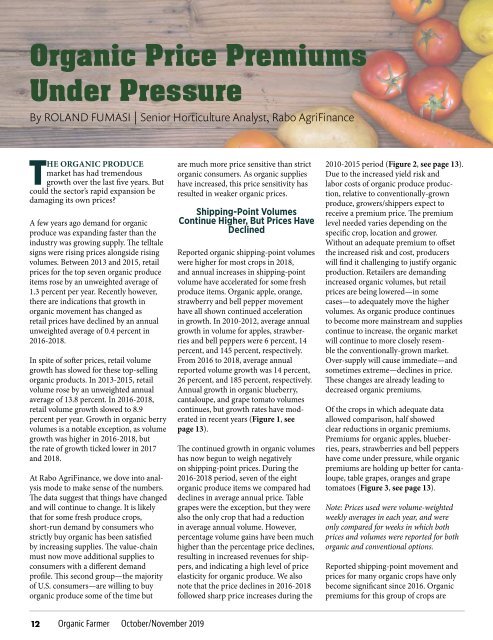Organic Farmer October/November 2019
You also want an ePaper? Increase the reach of your titles
YUMPU automatically turns print PDFs into web optimized ePapers that Google loves.
<strong>Organic</strong> Price Premiums<br />
Under Pressure<br />
By ROLAND FUMASI | Senior Horticulture Analyst, Rabo AgriFinance<br />
THE ORGANIC PRODUCE<br />
market has had tremendous<br />
growth over the last five years. But<br />
could the sector’s rapid expansion be<br />
damaging its own prices?<br />
A few years ago demand for organic<br />
produce was expanding faster than the<br />
industry was growing supply. The telltale<br />
signs were rising prices alongside rising<br />
volumes. Between 2013 and 2015, retail<br />
prices for the top seven organic produce<br />
items rose by an unweighted average of<br />
1.3 percent per year. Recently however,<br />
there are indications that growth in<br />
organic movement has changed as<br />
retail prices have declined by an annual<br />
unweighted average of 0.4 percent in<br />
2016-2018.<br />
In spite of softer prices, retail volume<br />
growth has slowed for these top-selling<br />
organic products. In 2013-2015, retail<br />
volume rose by an unweighted annual<br />
average of 13.8 percent. In 2016-2018,<br />
retail volume growth slowed to 8.9<br />
percent per year. Growth in organic berry<br />
volumes is a notable exception, as volume<br />
growth was higher in 2016-2018, but<br />
the rate of growth ticked lower in 2017<br />
and 2018.<br />
At Rabo AgriFinance, we dove into analysis<br />
mode to make sense of the numbers.<br />
The data suggest that things have changed<br />
and will continue to change. It is likely<br />
that for some fresh produce crops,<br />
short-run demand by consumers who<br />
strictly buy organic has been satisfied<br />
by increasing supplies. The value-chain<br />
must now move additional supplies to<br />
consumers with a different demand<br />
profile. This second group—the majority<br />
of U.S. consumers—are willing to buy<br />
organic produce some of the time but<br />
are much more price sensitive than strict<br />
organic consumers. As organic supplies<br />
have increased, this price sensitivity has<br />
resulted in weaker organic prices.<br />
Shipping-Point Volumes<br />
Continue Higher, But Prices Have<br />
Declined<br />
Reported organic shipping-point volumes<br />
were higher for most crops in 2018,<br />
and annual increases in shipping-point<br />
volume have accelerated for some fresh<br />
produce items. <strong>Organic</strong> apple, orange,<br />
strawberry and bell pepper movement<br />
have all shown continued acceleration<br />
in growth. In 2010-2012, average annual<br />
growth in volume for apples, strawberries<br />
and bell peppers were 6 percent, 14<br />
percent, and 145 percent, respectively.<br />
From 2016 to 2018, average annual<br />
reported volume growth was 14 percent,<br />
26 percent, and 185 percent, respectively.<br />
Annual growth in organic blueberry,<br />
cantaloupe, and grape tomato volumes<br />
continues, but growth rates have moderated<br />
in recent years (Figure 1, see<br />
page 13).<br />
The continued growth in organic volumes<br />
has now begun to weigh negatively<br />
on shipping-point prices. During the<br />
2016-2018 period, seven of the eight<br />
organic produce items we compared had<br />
declines in average annual price. Table<br />
grapes were the exception, but they were<br />
also the only crop that had a reduction<br />
in average annual volume. However,<br />
percentage volume gains have been much<br />
higher than the percentage price declines,<br />
resulting in increased revenues for shippers,<br />
and indicating a high level of price<br />
elasticity for organic produce. We also<br />
note that the price declines in 2016-2018<br />
followed sharp price increases during the<br />
2010-2015 period (Figure 2, see page 13).<br />
Due to the increased yield risk and<br />
labor costs of organic produce production,<br />
relative to conventionally-grown<br />
produce, growers/shippers expect to<br />
receive a premium price. The premium<br />
level needed varies depending on the<br />
specific crop, location and grower.<br />
Without an adequate premium to offset<br />
the increased risk and cost, producers<br />
will find it challenging to justify organic<br />
production. Retailers are demanding<br />
increased organic volumes, but retail<br />
prices are being lowered—in some<br />
cases—to adequately move the higher<br />
volumes. As organic produce continues<br />
to become more mainstream and supplies<br />
continue to increase, the organic market<br />
will continue to more closely resemble<br />
the conventionally-grown market.<br />
Over-supply will cause immediate—and<br />
sometimes extreme—declines in price.<br />
These changes are already leading to<br />
decreased organic premiums.<br />
Of the crops in which adequate data<br />
allowed comparison, half showed<br />
clear reductions in organic premiums.<br />
Premiums for organic apples, blueberries,<br />
pears, strawberries and bell peppers<br />
have come under pressure, while organic<br />
premiums are holding up better for cantaloupe,<br />
table grapes, oranges and grape<br />
tomatoes (Figure 3, see page 13).<br />
Note: Prices used were volume-weighted<br />
weekly averages in each year, and were<br />
only compared for weeks in which both<br />
prices and volumes were reported for both<br />
organic and conventional options.<br />
Reported shipping-point movement and<br />
prices for many organic crops have only<br />
become significant since 2016. <strong>Organic</strong><br />
premiums for this group of crops are<br />
12<br />
<strong>Organic</strong> <strong>Farmer</strong> <strong>October</strong>/<strong>November</strong> <strong>2019</strong>


















